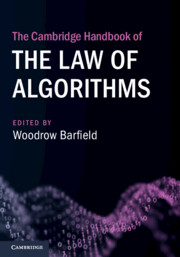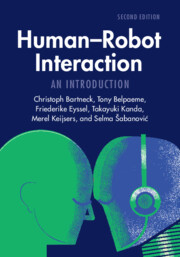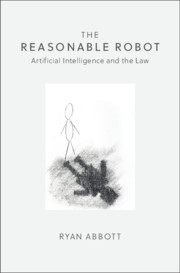The Cambridge Handbook of the Law, Policy, and Regulation for Human–Robot Interaction
This volume provides a unique perspective on an emerging area of scholarship and legislative concern: the law, policy, and regulation of human-robot interaction (HRI). The increasing intelligence and human-likeness of social robots points to a challenging future for determining appropriate laws, policies, and regulations related to the design and use of AI robots. Japan, China, South Korea, and the US, along with the European Union, Australia and other countries are beginning to determine how to regulate AI-enabled robots, which concerns not only the law, but also issues of public policy and dilemmas of applied ethics affected by our personal interactions with social robots. The volume's interdisciplinary approach dissects both the specificities of multiple jurisdictions and the moral and legal challenges posed by human-like robots. As robots become more like us, so too will HRI raise issues triggered by human interactions with other people.
- Provides an interdisciplinary and multidisciplinary study of law, ethics, and robotics
- Examines the design of humanoid, expressive, AI-enabled, anthropomorphic robots
- Analyzes how Japan, China, South Korea, Australia, the US, and the EU are just beginning to determine regulations for AI-enabled robots
Reviews & endorsements
‘In the heat of the lively global debate on AI regulation and governance, this Handbook masterfully reveals and addresses the unique legal, ethical, and policy challenges posed by the growing presence in society of a fascinating class of robots and their intense and multifaceted interaction with humans: AI-enabled, expressive, humanoid, and anthropomorphic robots. Beyond the unsatisfying ‘tool metaphor’ to approach human–robot interaction, this Handbook beautifully redirects the conversation down the path of the technological evolution of humans: ‘we seem to be creating technical versions of humanity that are embodied as robots.’ A comprehensive, interdisciplinary, thought-provoking work that contributes to the global dialogue by posing the right and real questions in acknowledging that humanity is, in fact, approaching a critical point. Fundamental. Teresa Rodríguez de las Heras Ballell, Charles III University of Madrid
‘This is a much needed work, which maps all the most significant social, ethical, and legal issues related to robotics, and addresses them from multiple and diverse perspectives, advanced from an amazing list of contributors. It will be equally useful for technologists, social scientists, or lawyers, but also for whoever intends to deploy robotic technologies with awareness of their social impacts, or to critically examine such deployment.’ Giovanni Sartor, European University Institute
‘A significant milestone as the first comprehensive book focusing specifically on the legal and regulatory landscape of human-robot interaction.’ ScienceBlog
Product details
November 2024Hardback
9781009386661
888 pages
262 × 185 × 51 mm
1.81kg
Available
Table of Contents
- Forward
- Preface
- 1. Introduction to law, policy, and regulations for human-robot interaction
- 2. Anthropomorphism and human-robot interaction (HRI)
- 3. Human-robot interaction implications: for law, policy, and regulations
- 4. Trust-based interfaces in hr interaction. context, communication and information
- 5. Robots, regulation, and the changing nature of public space
- 6. Challenges of the legal protection of human lives in the time of anthropomorphic robots
- 7. What will robot laws look like? Considering code, AI and human laws
- 8. Oversight boards for regulation of AI-enabled robots
- 9. Building a smart legal ecosystem for industry 5.0
- 10. I, Robot? legal personality for robots and the android fallacy
- 11. 'Legal being': going beyond the debate of legal personhood for 'intelligent' non-humans
- 12. Robot romance
- 13. Robot natives: future design and regulations for baby robot interaction
- 14. Should social and assistive robots integrated within home- and healthcare services be universally designed?
- 15. Regulating emotional artificial intelligence in cars
- 16. Some critical thoughts on anthropomorphic social robot design
- 17. A critical analysis of consent in human–robot interaction
- 18. Rosie is a rental: what thriving interactive robotics could mean for our society
- 19. Bots against bias: critical next steps for human-robot interaction
- 20. Robot ethics for interaction with humanoid, AI-enabled and expressive robots
- 21. The ubuntu robot: towards a relational conceptual framework for intercultural robotics
- 22. Ethical, legal, and social concerns in the application of social robots in religious settings: a case study of the catholic robot santo
- 23. Helpers for helpers: ethical and legal considerations for long-term care robots
- 24. Ethical design and standardization for robot governance
- 25. Eight recommendations for ethical and legal assessments of robotic systems interacting with humans
- 26. Cultural differences in social robot perception
- 27. Moral interaction with social robots
- 28. I'm not like the others, I'm your friend: towards an ethics for AI in behavioural interventions and choice architectures
- 29. Personal autonomy and machine autonomy in human-robot interaction
- 30. Robots in a civilized society: should robots be taught to adhere to social norms?
- 31. Racialization and bias toward humanoids
- 32. Privacy considerations for socially assistive robots
- 33. Privacy and transparency in human-robot interaction
- 34. Robotic torts
- 35. Limits of criminal law regulation of robotics: the Russian federation law perspective
- 36. Robot criminal liability
- 37. The use of artificial intelligence on criminal proceedings with robot judges as a different dimension
- 38. The first amendment and robots in virtual and physical worlds
- 39. Humanoid robots and consumer law and policy
- 40. Therapy without therapists: human-robot interaction under the EU medical device regulation and the artificial intelligence act
- 41. Legal analysis of a social robot: the appropriation of ideas and labor
- 42. Considering the tax policy implications of automation and AI-enabled robots
- 43. Humanoid AI systems for healthcare in outer space: a new generation of opportunities and legal puzzles
- 44. Ensuring accountability for robots and AI under criminal law
- 45. Intelligent industrial and service robots: a discussion of international human rights
- 46. Concluding thoughts on future directions in law, policy, and regulations for human-robot interaction.





